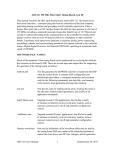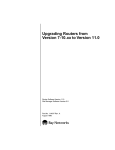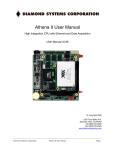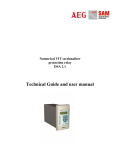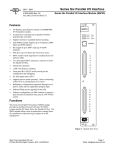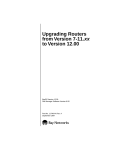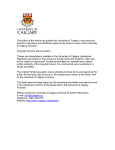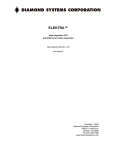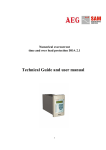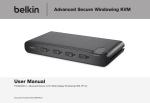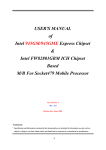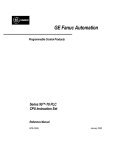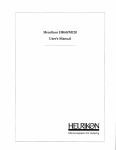Download VME INTERFACE BOARD
Transcript
VME INTERFACE BOARD This document describes the VME interface board Revision 7A dated 12/11/97, targeted to operating Gen II controllers at full speed. The VME interface board is a 6U wide board that supports the full 32-bit address and data paths of the two connector VMEbus specification C.1. It continues the evolution of two previous VME interface boards by incorporating their features, including support for the faster fiber optic protocol of Gen II controllers, a fast FIFO data buffer on incoming data from the timing board, a x2 faster DSP, more generalized support for VMEbus arbitration and interrupt generation, and a parallel data path for incoming data to be transmitted off-board. A block diagram of the VME board is shown in Fig. 1, and a functional description of the board follows. Part numbers are located on an accompanying parts drawing. The Motorola DSP56002 chip U15 manages the board functions, serving as a communications node and address generator in direct memory access (DMA) mode when the board is writing images to the VMEbus. It operates at an internal clock speed of 64 MHz, using an internal phase locked loop (PLL) circuit that multiplies the external VMEbus system clock of 16 MHz by four. It operates at an instruction processing speed of 32 MHz, or 31.25 nanosec per single word instruction. A OnCE connector is installed on the board for use of the Motorola supplied in-circuit emulator as an aid to writing DSP code. The VME interface board DSP transmits to the timing board using its internal synchronous serial interface (SSI) at a speed of 4 MHz though the ODL50 series fiber optic transmitter U44. It receives data from the timing board at a speed of 50 MHz (for Gen II controllers) or 40 MHz (for Gen I) from the fiber optic serial receiver chip U34 using the clock recovery circuit U35 to generate a synchronous clock, a serial to parallel shift register circuit implemented in PAL U29, and a first-in first-out (FIFO), 1k x 18 bit memory U30 and U36. The FIFO generates a DSP interrupt through the PAL U26 on line B and de-asserts its empty flag that is monitored by the DSP if it has any contents. The DSP is programmed to respond to interrupts when it expects commands and replies from the timing board, and to monitor the empty or half full flags when image data is expected. The serial shift register PAL U29 is currently does not support 18-bit image data. A single memory-mapped VMEbus address is used to write commands to the DSP, determined by the addressing jumpers JA1 - JA31. Long word (32-bit data) writes of either extended (32-bit address space) or standard (24-bit address space) accesses to the address will causes the comparators U12, U16, U18 and U20 and the PAL U14 to be asserted, generating a high going pulse on BRDSEL, in turn generating a DSP interrupt level A signal with the flip flop U24A. The DSP jumps to an interrupt service routine that reads the 24-bit data word that has been latched onto U32, U38 and U40 by the RDCLK signal generated from BRDSEL and processes it as a command word. A write to the command address +4 will cause a DSP reset signal to be generated, allowing the board to be reset by software. The DSP writes data to the VMEbus by writing the 32-bit VMEbus address and either 24- or 32-bit data to latches that are asserted onto the VMEbus when the bus arbitration logic indicates that the bus is available. The high address lines A16-A31 are written to the latches U21 and U23 only when they change. The low address lines A01-A15 are written to the latches U17 and U19 and the data D0-D23 are written to the latches U25, U28 and U31 whenever the DSP writes to the VMEbus. Upon writing to these latches the bus arbitration circuit (PAL U9 = C, U6 and U8) makes a request for ownership of VMEbus Interface Board, pg. #1 Updated Jan. 13, 1999 BG#IN, AS, DTACK VME BUS ARBITRATION DSP-WR TO TIMING BOARD BR#, BG#OUT D0-D7 FIBER OPTIC TRANSMITTER # = 0 TO 3 VMEbus IRQA IRQB VME SSI WRAM DSP56002 PA AM0-AM5 VME PA DSP-WR A0-A14 A01-A15 VME FROM TIMING BOARD RSTWDT RESET IRQ5 INTERRUPT RQINTR FIBER OPTIC RECEIVER D0-D23 PROCESSOR D00-D07 VME ADDRESS A01-A31 32K X 24 SRAM SHIFT IRQA, BRDSEL RDCOM DECODE REGISTER 1K X 16 FIFO IRQB RST-FIFO RDFIFO D0-D7 BOOT ROM A0-A15 Misc. DSP ADDRESS DECODE ADDRESS BUS A00 - A15 WRHADR D00-D15 AM0-AM5 Misc. RDFIFO WRHADR WRHDATA RDCOM RST-FIFO RQINTR DSP-WR WRAM RSTWDT CE-ROM A16-A31 VME DSP-WR DATA BUS D00-D23 D00-D31 VME BRDSEL D00-D23 RDCOM WRHDATA D16-D31 VME Fig. 1: Block diagram of the VME interface board. VMEbus Interface Board, pg. #2 Updated Jan. 13, 1999 the bus. A bus request BR# is asserted (# = 0 to 3), the VMEbus bus arbiter responds with a bus grant BG#, and the VME/I signal asserts the address and data onto the bus by enabling the outputs of the latches. The address modifiers AM0 to AM5, and the control lines LWORD/I and WRITE/I are asserted by a latch from values written previously by the DSP. The bus arbitration logic then asserts the data and address strobe lines with U1, and terminates the bus cycle when DTACK/I low is detected. Two modes are implemented for efficient transfer of pixel data to the VMEbus. In both cases the pixel data is written from the FIFOs directly to the latches in 32-bit per word mode, bypassing the DSP. One mode, termed "rdfifo" in supporting signal names and DSP code, is activated whenever the range of addresses Y:$8000 to Y:$FFFF is written to if when the address X:SETRDFIFO has been written to, causing the PAL U7 to move two 16-bit words directly from the FIFO to the bus latches. The second efficient way of writing image data is using the block transfer mode of VMEbus data transfer wherein the addresses are not written to the bus on every data transfer, but only at the beginning of a block transfer. This mode carries the "blt" designation in signal names and DSP code, following its VMEbus name. The memory being written on the VMEbus to must support the block transfer mode to use this mode. Normally replies and commands are written as long words to the VMEbus by asserting LWORD/I. However, only the 24 least significant bits are valid because that is the word length of the DSP. The remaining 8 most significant bytes are written as all high, $FF, because they’re pulled up by the VMEbus terminators. In image transfer mode the data is normally written in 32-bits format in one transfer by writing the most significant 16-bits to the latches U37 and U39 prior to writing the least 16-bits to the normal VMEbus address space, and the entire 32-bit data word will be transferred in one cycle over the VMEbus. In "rdfifo" and "blt" modes this is done in hardware by PALs, or the user can do the same thing in software by writing to the appropriate registers. Additional circuits complete the board. There is a memory bank of fast static RAM for buffering incoming image data, 32k x 24-bits in size. There is a byte-wide ROM that contains boot code that is loaded into the DSP after it exits the reset state, and can contain application code that is loaded on command. The PAL U7 does the address decoding of all the DSP commands to effect the operations discussed. Its memory map is given below. There is a watchdog timer and power monitor circuit U27 that resets the DSP if incoming power falls below 4.75 volts, and a jumper that can be set to reset the DSP if the RSTWDT (reset watchdog timer) command is not executed at least once every 62.5 milliseconds. There is an interrupt processor circuit that will generate interrupts when the DSP issues the appropriate command, and supports the generation of a byte-sized vector during interrupt processing. The interrupt vector is specified by writing to the WRAM register. There is a connector mounted on the front panel, CON24, that can be used to pass 16-bit image data from the output of the FIFO to another board without passing through the VMEbus, with a handshaking flag to indicate when data from a frame is being transferred. DSP Memory Map and Control Bits Definitions The DSP memory map follows, with an explanation of what each command does. Often users will have to consult provided DSP source code and even the board schematic to fully comprehend the instruction processing. The names of the operation are the same labels equated to the addresses in the DSP source code. VMEbus Interface Board, pg. #3 Updated Jan. 13, 1999 WRAM X:$FFB0 RDFIFO X:$FFB1 WRHADR X:$FFB2 WRHDATA X:$FFB3 RDCOM X:$FFB4 RQINTR RSTWDT RSTFIFO SELBLT SETRDFIFO CLRRDFIFO X:$FFB5 X:$FFB6 X:$FFB7 X:$FFB8 X:$FFB9 X:$FFBA Write address modifiers AM0-AM5, and VME control signals WRITE/I and LWORD/I to a latch for assertion during VMEbus bus master cycles. D0-D5 = AM0-AM5, D6 = WRITE/I, D7 = LWORD/I and D16-D23 = interrupt vector. Read 18-bit word from the FIFO. It contains image or command/reply data from the timing board. Write the high VME address bits A16-A31 to latches for assertion onto the VMEbus on the next VMEbus master cycle. Write the DSP data lines D0-D15 on latches for assertion onto the VMEbus data lines D16-D31 on the next bus master cycle if a 32-bit data transaction has been requested by sending the WORD-LENGTH bit of the DSP port B to 32-bit size. Read incoming commands from the VMEbus data lines D00-D23 to the DSP. Write to this address to request VMEbus interrupt service. Write to this address to reset the watchdog timer. Write to this address to reset the FIFO. Begin writing a block in block transfer mode Select for operating the "rdfifo" automated mode De-select the "rdfifo" mode Memory read and writes operations to the memory spaces P:, X: and Y: get interpreted in different ways depending on the address of the operation. Reads or writes to the following two memory ranges cause either access to the VMEbus and a full arbitration and data transaction to occur, or an access to the on-board EEPROM memory Y:$8000 to $FFFF Read or write to or from the VMEbus. P:$8000 to $FFFF Read or write to on-board EEPROM memory. A fast static RAM memory bank (SRAM) that is 32k x 24 bits in size is located on the board, and split into three separate memory spaces. P: and X: operations each access 8k segments of the memory, and Y: operations access the remaining 16k segment. SRAM in inaccessible for P: address below $200 and X: or Y: addresses below $100 because these memory operations access internal DSP memory instead. P:$200 to $1FFF X:$100 to $1FFF Y:$100 to $3FFF Read or write to or from external SRAM memory. Read or write to or from external SRAM memory. Read or write to or from external SRAM memory. The following bits are controlled directly by the DSP port B. The are configured as general purpose I/O pins, variously as inputs or outputs, and used to control various board functions. They are controlled by the following programmeable pins - VMEbus Interface Board, pg. #4 Updated Jan. 13, 1999 Bit # Name 0 BLT 1 REM_RST I/O Output Output 2 MODE Output 3 4 AUX1 H4 Output 5 H5 Output 6 7 AUX5 REQBUS/I Output 8 9 AUX2 AUX3 Output Input 10 11 12 13 AUX4 HASBUS Input WORD-LENGTH Output DONEVME Input 14 HF/I Input Function Set to enable block transfer mode to the VMEbus. Set to reset the remote circuit board. It is mapped to pin #17 of the external data connector CON24. Set to receive 32-bit command/reply data and clear to receive 16-bit image data. 18-bit image data is not supported. Unused. Value of data strobe signal DS0/I asserted on VMEbus cycles. It is asserted as a zero, indicating 32-bit data transfers. Value of data strobe signal DS1/I asserted on VMEbus cycles. It is asserted as a zero, indicating 32-bit data transfers. Unused. Clear to request VME bus ownership. This can be used to gain VME bus mastership ahead of a block of transfers for improved speed compared to requesting the bus on every transfer. Can be used to generate an FYNC signal from the DSP. Connected to signal FSYNC inside PAL U29 for the DSP to monitor it. See the adaptive optics port discussion below. Unused. Set to indicate that the board is the current VMEbus master. Set to write 32-bit data words to the VMEbus, clear for 24-bit. Set to indicate that the board is finished with the VMEbus transaction and available for the next one. Cleared to indicate that the input FIFO is half full. Continuing on, the following bits are controlled by the DSP, but from port C, available by reading or writing from or to the address X:$FFE5 = X:PCD. As of this writing DSP code has not been written to implement the bus arbitration options other than the prioritized, jumper selected one. 0 BCLR Input Routed from VMEbus arbitration signal BCLR for implementation of Round Robin bus arbitration protocol. 1 BR0 Input Routed from VMEbus arbitration signal BR0 for implementation of FAIR bus arbitration protocol. 2 BR1 Input Routed from VMEbus arbitration signal BR1 for implementation of FAIR bus arbitration protocol. 3 BR2 Input Routed from VMEbus arbitration signal BR2 for implementation of FAIR bus arbitration protocol. 4 BR3 Input Routed from VMEbus arbitration signal BR3 for implementation of FAIR bus arbitration protocol. 5 Unused 6 Serial transmitter clock, not general purpose I/O. 7 EF/I Input Cleared to indicate that the input FIFO is empty. 8 Serial transmitter data, not general purpose I/O. VMEbus Interface Board, pg. #5 Updated Jan. 13, 1999 15K SIP VMEbus command address A01-A31. A jumper installed clears the address bit to a zero. The default address indicated is $1a000000. M0 M1 M2 L0 L1 L2 N 15K SIP IACK0 IACK1 IACK2 15K SIP ADR sets the Address Modifier mode for processing incoming VMEbus commands. M0-M2, L0-L2 and N set the speed of the fiber optic receiver. The default shown is 50 MHz. Other speeds are shown in the text. IACK0-IACK2 sets the interrupt acknowledge level processed by the board, digitally encoded. IACK0 maps to A03 and IACK2 maps to A01, a silk screen bug. Interrupt request level, 0 to 7. Only one jumper should be installed, and it must match the acknowledge level of jumpers IACK0-IACK2. Bus request and grant levels, allowing a choice of levels 0 to 3. The default level 3 is shown. These are located right above the ROM socket. EEPROM (28C256), write disabled EEPROM, write enabled UV ROM (27C256) The reset watch dog timer jumper is located to the right of the DSP. This selection disables the watch dog timer. This selection enables the watch dog timer, requiring a RSTWDT instruction at least every 62.5 milliseconds. When installed this jumper selects the serial receiver for operation with Gen I controllers. Jumper Settings There are many jumpers on the board to select operating modes and addresses. The default settings are as follows Command address = $1a000000 Fiber optic speed = 50 MHz Address modifiers = $ Interrupt level = 7 Bus request level = 3 ROM = write disabled EEPROM Watch dog timer = disabled Reset address = command address + 4 VMEbus Interface Board, pg. #6 Updated Jan. 13, 1999 Generation II = selected The figure shows the schematics of the jumper blocks with the default jumper settings. The command address is determined by four rows of jumpers, labeled in the silk screen on the board by the upper and lower address bit number on each end. Installing a jumper selects a zero for the address bit. The VMEbus specification requires that address modifier lines AM0-AM5 be set on all bus transfers. The jumper labeled ADR near the PAL U14 selects between the three following address modes Jumper on the top two pins: AM = $39, Standard (24-bit) non-priviledged data access Jumper on the bottom two pins: AM = $09, Extended (32-bit) non-priviledged data access No jumper installed: AM = $09 or $39, either standard or extended non-priviledged data access A group of jumpers located behind the fiber optic components selects the speed of the fiber optic receiver, the interrupt acknowledge level and the address modifier. The jumper settings for three fiber optic speeds are shown in the table below. M0 M1 M2 L0 L1 L2 N 4 MHz (self-test) open open jumper open open jumper jumper 40 MHz (Gen I) 50 MHz (default) jumper jumper jumper jumper jumper jumper open jumper jumper jumper jumper jumper open open The default setting is 50 MHz, which is the frequency of the timing board transmitter on Generation II controllers. The 4 MHz setting is used to exercise the interface board in a loopback self-test that maps the 4 MHz transmitter of the board directly to the receiver. The 4 MHz jumper setting may be of interest if a self-test feature is ever implemented since the fiber optic transmitter speed is 4 MHz. The 40 MHz is used to operate Generation I timing board serial transmitter, though the serial receiver PAL does not now support this. Interrupt request levels are selected by the jumper block IRQ0 to IRQ7 located near the VMEbus connectors. Installing a jumper simply selects that level, with level 7 being the highest priority. The interrupt acknowledge level from 0 to 7 is selected by the three jumpers IACK0 to IACK2 located in the fiber optic receiver area, binary encoded. The interrupt request and acknowledge levels must be set to be the same number for normal interrupt processing.Installing a jumper represents a zero (0) and no jumper represents a one (1). But there is a bug in the silk screen labelling on the board wherein the IACK0 and IACK2 labels have been switched. IACK2 is the least significant bit and IACK0 is the most significatn bit. The default setting for the board is for interrupt level 7, so a jumper is placed on the IRQ7 line and no jumpers are placed on IACK0-2. Mastership of the bus must first be established for the interface board to transfer data over the VMEbus. This is done by requesting the bus at one of four priority levels, selected by jumpering one VMEbus Interface Board, pg. #7 Updated Jan. 13, 1999 of the levels BR0 to BR3. For proper operation, the same level must be selected in the bus grant jumper block by placing jumpers two jumpers, one on the left side and one on the right side of the bus grant jumper at the desired bus request level. Jumpers must also be placed on the center pair of jumper posts for the other request levels to pass the unwanted bus grant signals through the board onto other boards in the system that may need them. Three options exist with the ROM memory part located below the fiber optic components. These are to install an electrically erasable ROM that is write disabled, the same part but write enabled, and a UV erasable, read only ROM. The jumper settings for these three cases is shown in the figure. A reset watch dog timer circuit is installed to reset and reboot the board, including the DSP, if the software is not executing properly. To enable the watchdog timer circuit a jumper needs to be placed on the right hand side of the little RSTWDT block below PAL U7, and instructions must be placed in the DSP code to insure that the corresponding DSP memory location is written to at least every 62.5 milliseconds. Finally, a jumper below the DSP can be installed to select Generation I serial receiver data formats, although the serial receiver PAL to do this has not yet been developed at the time of this writing. Users desiring this feature should contact the designers for help. Adaptive Optics Port A 24-pin IDC connector (male) J4 is installed to serve as a parallel image data port that can be connected directly to image processing hardware, and is called the ’C80 data port since it was designed to interface to thye Texas Instruments ’C80 family of DSPs. The pinout of the connector is given below 1 3 5 7 9 11 13 15 17 19 21 23 D06 D04 D02 D00 D14 D12 D10 D08 REM-RST FIFORD EF* FSYNC 2 4 6 8 10 12 14 16 18 20 22 24 D07 D05 D03 D01 D15 D13 D11 D09 No connection GND GND GND The lines D00 to D15 contain image data transmitted over the fiber optics data link from the timing board after they have been bufferred by the FIFO on the VME board. VMEbus Interface Board, pg. #8 Updated Jan. 13, 1999 REM-RST FIFORD EF* FSYNC An output signal from the DSP bit D1 of the parallel port B used for initializing the hardware connected to the ’C80 port. A low true signal input to the VME board routed to the RD* pin of the FIFO. The FIFOs are generic type 7202 1k word deep devices with 12 nanosec access times, requiring that the FIFORD signal be at least this long. A low true output from the VME board that indicates that the FIFO is empty. Output from the VME board, this signal will equal the value of the incoming serial data word bit D0 if D15 = 1 and the AUX2 bit #8 of parallel port B equals 1. It is intended to be as a synchronization signal to that is high when image data is being transmitted. Note that 16-bit image data is processed by the port if the VME board is not set to generate the frame sync signal FSYNC. If a frame sync is needed then the most significant bit of the image D15 is used to encode the frame sync information and only 15-bit image data can be transmitted. To effectively use this port capability with the timing board its PALs U12 and U17 must be revision 4.1 or later. All timing board manufactured and delivered on or after May 15, 1998 have this or later revision PALs, so users of boards manufactured earlier than that date should request current revision PALs if they want to use this capability. The detailed functionality of the timing board PALs is described in the timing board user’s manual, and DSP code is given below to operate both the timing and VME boards in this mode. In the following code segments PBDDR = $FFE2 is the address of the port B data direction address register, and PBD = $FFE4 is its data register. The VME board DSP code needs to initilize the Port B bit #8 to an output, as follows BSET #8,X:PBDDR ; Set bit #8 - AUX2 to an output Similarly, in the timing board readout code, two lines need to be set to outputs and initialized FD15 EQU FMODE EQU BSET BSET BSET 10 12 #FD15,X:PBDDR #FMODE,X:PBDDR #FMODE,X:PBD ; Value of forced data bit 15 ; Forced data bit 15 mode if set ; Set this bit to an output ; Set this bit to an output ; Put board in forced bit mode The RDCCD routine should set SYNC high at the beginning of the frame readout BSET MOVEP BCLR #FD15,X:PBD #>1,Y:WRFO #FD15,X:PBD ; Force D15 = 1 ; Transmit D0 = 1 to the VME board ; Force D15 = 0 and then clear SYNC at the end of the frame readout VMEbus Interface Board, pg. #9 Updated Jan. 13, 1999 REP NOP BSET MOVEP BCLR REP NOP #20 ; Wait for the last pixel transmission #FD15,X:PBD #0,Y:WRFO #FD15,X:PBD #10 ; Force D15 = 1 ; Transmit D0 = 0 to the VME board ; Force D15 = 0 ; Wait for the last pixel transmission and possibly put the timing board in non-forced data bit D15 mode if images are not to be transmitted continuously BCLR #FMODE,X:PBD ; Take the board out of forced bit mode Application commands The DSP software chapter describes the commands that are located in the "vmeboot" program that is loaded from EEPROM after the DSP is reset, and are in common with the other DSP boards in the system. These are the read and write memory commands (RDM and WRM), the test data link command (TDL) and the load application command (LDA). Every command to the interface board is prefaced with a header word, consisting of a source byte, a destination byte and a number of commands words byte. The interface board is number one, as determined by the DSP boot code. All commands with a one for the destination byte are processed by the VME interface board; commands with destination bytes of two or three are passed to the timing board through the fiber optic data link, and destination bytes of zero are passed to the host computer through the VMEbus. Headers with destination bytes outside this range are ignored, as processing continues on to the next word in the command string. Replies are made to the VMEbus by writing to an address space specified with the Set Reply Address (’SRA’) command, which is of the form $000104 ’SRA’ high 16-bits of address low 16-bits of address Replies to commands will always consist of a header containing source, destination and command length bytes, followed by at least one word that may contain data or ASCII codes. The SRA command will generate a reply to the VMEbus starting at the address specified in its argument list, and the next command reply will start eight bytes away. The reply to many commands is a simple ASCII ’DON’ meaning that the command was executed successfully, or an ’ERR’ meaning that it was not successful. The replies will be written starting at the address indicated by ERA and incremented over a 128 byte range, after which it will restart at the address specified by SRA. Users may either use this circular addressing scheme or may issue frequent SRA commands to keep the address from circling. An addressing limitation is that the 128 byte reply area must not cross a 64k byte VMEbus address boundary. All replies also result in an optional interrupt being requested by the interface board so the device driver can efficiently process the replies. A timeout feature writes a ’TIM’ reply if a complete command is not received in 50 milliseconds, controlled by the TIMEOUT constant. VMEbus Interface Board, pg. #10 Updated Jan. 13, 1999 Several commands are implemented in the application code "vme1.asm’. The RDC and ABR commands are also implemented by the timing board, but execute differently. These commands are as follows: RDC ABR Read CCD - Set up interface board to read out CCD. All further data from the timing or utility boards will be interpreted as 16-bit/pixel image data. Switching back to 32-bit command/reply mode will occur after the VME interface board has counted the number NPXLS of data points. Abort Readout, and place interface board in command processing mode. Issue an abort readout command to the timing board. SRA is a boot command, and the remaining ones are application commands. A single word is encoded to contain status information about the board processing state. It is located at the data memory word X:0, which can be read or written from the host with RDM or WRM command. Host computer command: Interface board reply: $000103 $010002 ’RDM’ value $200000 The following bits are defined for X:STATUS = X:0 bit 0 Set by the DSP program if it is in readout mode, cleared if in command processing mode. bit 2 Set if an SRA command has been executed since the last DSP boot. If not then replies will not be generated. bit 3 Set if a command being processed was received from the timing board, cleared if it came from the host computer. This is used internally for command processing. An options word defined at X:1 is used to set firmware execution options. It can be written to or read with the commands: Host computer command: Host computer command: Interface board reply: $000104 $000103 $010002 ’WRM’ ’RDM’ value $200001 $200001 value The following bits are defined for X:OPTIONS = X:1 bit 1 Set to require that the interface board request VMEbus interrupt service after each command reply and after the all the images have all been transferred. Default is no interrupts. bit 2 Set to require that the DSP translate the incoming 16-bit straight binary image data to twos complement format for compatibility with the FITS. It will convert data over the range from [0 to 64k] -> [-32k to +32k]. Default is no conversion. "vme1" Application Program # 1 This application reads from a single readout, being the simplest of the applications. It can be VMEbus Interface Board, pg. #11 Updated Jan. 13, 1999 downloaded from the host computer or loaded from on-board ROM memory with the command ’LDA 1’. The number of pixels to be read is stored in the DSP memory location Y:1. However, if the number of pixels to be read exceeds the 24-bit range of the DSP data values (16 Mpixels) then the number of columns to be read can be written to Y:2 and the number of rows to Y:3, with the product of the two numbers being calculated by the DSP to determine the number of pixels to be read up to 8 Gpixels. If the number of pixels is non-zero then it will determine the number of pixels to be read. The starting VMEbus address where the image data will be written to is set by the host computer by writing to a table in DSP memory. The address lines A0-A9 must be zero for this program to work properly, that is, the image buffer must start on a 1024 byte (1k) boundary. This table is not overwritten by the DSP program, so only needs to be written only once. The table begins at Y:VME_TBL = Y:$40 and a contains a pair of addresses containing the high and low 16-bits of the 32-bit VMEbus address. A shadow buffer is maintained by the DSP starting at address Y:$60 that contains the current addresses being written to by the DSP, and is initialized to the starting address table at the beginning of readout. For setting this up the host computer should issue the commands $000104 $000104 $000104 $000104 $000104 ’WRM’ ’WRM’ ’WRM’ ’WRM’ ’WRM’ $400040 $400041 $400001 $400002 $400003 highest 16-bits of VMEbus address lowest 16-bits of VMEbus address NPXLS - Total number of pixels to be read NCOLS - Number of columns to be read NROWS - Number of rows to be read Readout will begin once the interface board receives an RDC command. The interface board will be placed in readout mode whereby any data received from the timing board over the fast fiber optic data link will be interpreted as image data until the desired number of pixels is received. Image data is allowed to accumulate in the image FIFO buffer in 512 pixel blocks, then transferred a block at time as quickly as possible over the VME bus. The image data will be written back to the VMEbus at 16 bits per pixel in 32-bit words, setting the VMEbus control lines DS0 = DS1 = LWORD = 0, except for the last portion of the image that is less than or equal in size to half the FIFO buffer (512 pixels) which gets written to the VMEbus in 16-bit words. The number of pixels received since the start of readout can be read from the location Y:NBLOCKS = Y:4, as follows: $000104 ’RDM’ $400004 NBLOCKS - Number of 512-pixel blocks read so far Processing this command interrupts the processing of image data with a fair amount of overhead, so should not be executed too often in high data rate applications. As of this writing the abort command ABR has not been implemented. VMEbus Interface Board, pg. #12 Updated Jan. 13, 1999












